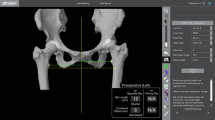Abstract
Surgeons want to perform a perfect total hip replacement (THR) with every operation. Human performance has limitations, especially when performing a mechanical operation in a biological environment. Recent suggested changes to improve outcomes have been large femoral heads and anterior incisions, but unfortunately neither has resulted in any scientific data that change has been effected. The scientific data does tell us that poor component positions and impingement are the source of increasing mechanical complications. Therefore, attempts to improve the surgeon’s performance by precise quantitative knowledge in the operating room have been used. We discuss robotic guided navigation as a solution. This technology provides predictable and reproducible results.



Similar content being viewed by others
References
Papers of particular interest, published recently, have been highlighted as: • Of importance •• Of major importance
Kim YH, Kim JS, Park JW, Joo JH. Comparison of total hip replacement with and without cement in patients younger than 50 years of age. J Bone Joint Surg [B]. 2011;93B:449–55.
Callaghan JJ, Forest EE, Olejniczak JP, Goetz DD, Johnston RC. Charnley total hip arthroplasty in patients less than 50 years old; a 20–25 year follow-up note. J Bone Joint Surg Am. 1998;80-A:704–14.
Malik A, Maheshwari A, Dorr LD. Impingement with total hip replacement. J Bone Joint Surg Am. 2007;89(8):1832–42.
• Bozic KJ, Kurtz SM, Lau E, Ong K, Vail TP, Berry DJ. The epidemiology of revision total hip arthroplasty in the United States. J Bone Joint Surg Am. 2009;91(1):128–33. This study showed that hip instability and mechanical loosening are most common causes for revision total hip arthroplasty.
Cram P, Lu X, Kaboli PJ, Vaughan-Sarrazin MS, Cai X, Wolf BR, et al. Clinical characteristics and outcomes of Medicare patients undergoing total hip arthroplasty. JAMA. 2011;305(15):1560–7.
•• Callanan MC, Jarrett B, Bragdon CR, Zurakowski D, Rubash HE, Freiberg AA, et al. Risk factors for cup malpositioning: quality improvement through a joint registry at a tertiary hospital. Clin Orthop Relat Res. 2011;469:319–29. This study showed the factors correlated with cup malpositioning and has commented that navigation assistance increases the accuracy of cup position.
Epstein NJ, Woolson ST, Jiori NJ. Acetabular component positioning using the transverse acetabular ligament: can you find it and does it help? Clin Orthop Relat Res. 2011;469:412–6.
Jewett BA, Collis DK. High complication rate with anterior total hip arthroplasties on a fracture table. Clin Orthop Relat Res. 2011;469:503–7.
Hammerberg EM, Wan Z, Dastane M, Dorr LD. Wear and range of motion of different femoral head sizes. J Arthroplasty. 2010;25:839–43.
Hart AJ, Ilo K, Underwood R, Cann P, Henckel J, Lewis A, et al. The relationship between the angle of version and rate of wear of retrieved metal-on-metal resurfacings. J Bone Joint Surg Br. 2001;93-B:315–20.
Harris WH. The correlation between minor or unrecognized developmental deformities and the development of osteoarthritis of the hip. Instr Course Lect. 2009;58:257–9.
Lazennec JY, Boyer P, Gorin M, Catone Y, Rosseau MA. Acetabular anteversion with CT in supine, simulated standing, and sitting positions in a THA patient population. Clin Orthop Relat Res. 2011;469:1103–9.
• Dorr LD, Wan Z, Malik A, Zhu J, Dastane M, Deshmane P. A comparison of surgeon estimation and computer tomographic measurement of femoral component anteversion in cementless total hip arthroplasty. J Bone Joint Surg Am. 2009;91(11):2598–604. This study showed that even the experience surgeon has poor precision for estimation of stem anteversion and concluded that intraoperative use of computer is important for achieving safe combined anteversion.
•• Zhu J, Wan Z, Dorr LD. Quantification of pelvic tilt in total hip arthroplasty. Clin Orthop Relat Res. 2010;468(2):571–5. This study showed that quantitative knowledge of pelvic tilt is important in operating room for accurate cup position especially allowing anteversion to be measured in coronal plane.
Murray DW. The definition and measurement of acetabular orientation. J Bone Joint Surg Br. 1993;75(2):228–32.
Dorr LD, Malik A, Dastane M, Wan Z. Combined anteversion technique for total hip arthroplasty. Clin Orthop Relat Res. 2009;467(1):119–27.
• Little NJ, Busch CA, Gallagher JA, Rorabeck CH, Bourne RB. Acetabular polyethylene wear and acetabular inclination and femoral offset. Clin Orthop Relat Res. 2009;67:2895–900. This study showed that proper cup position and femoral offset restoration to normal are important for reduced polyethylene wear rate.
Sakalkale DP, Sharkey PF, Eng K, Hozack WJ, Rothman RH. Effect of femoral component offset on polyethylene wear in total hip arthroplasty. Clin Orthop Relat Res. 2001;388:125–34.
Dastane M, Dorr LD, Tarwala R, Wan Z. Hip offset in total hip arthroplasty: quantitative measurement with navigation. Clin Orthop Relat Res. 2011;469:429–36.
Disclosures
R. Tarwala: none; L. Dorr: stock/stock options in Mako and Total Joint Orthopedics.
Author information
Authors and Affiliations
Corresponding author
Rights and permissions
About this article
Cite this article
Tarwala, R., Dorr, L.D. Robotic assisted total hip arthroplasty using the MAKO platform. Curr Rev Musculoskelet Med 4, 151–156 (2011). https://doi.org/10.1007/s12178-011-9086-7
Published:
Issue Date:
DOI: https://doi.org/10.1007/s12178-011-9086-7




